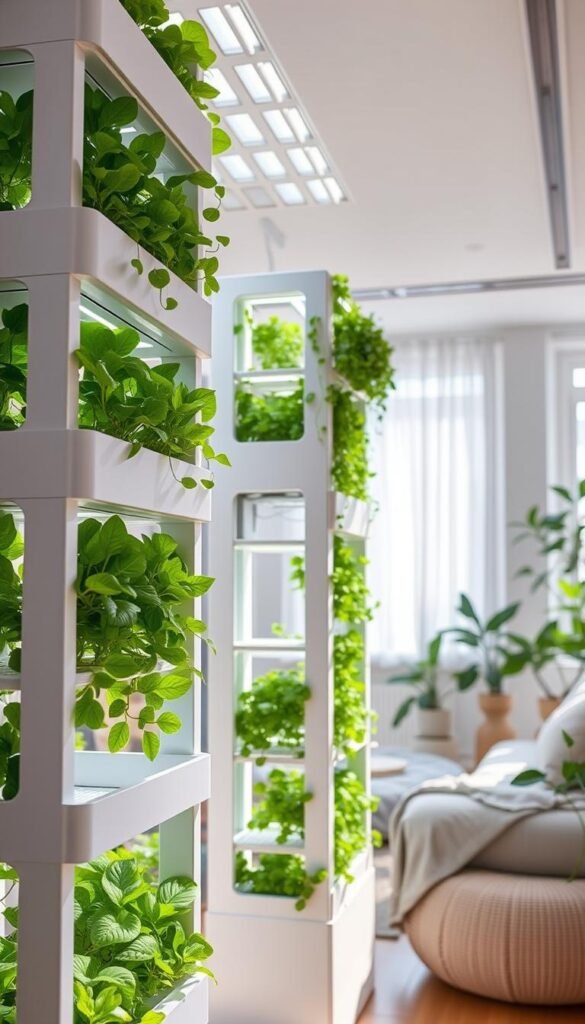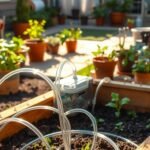Imagine growing herbs, veggies, or flowers without soil or backyard space. Urban dwellers are redefining home gardening by stacking plants upward instead of outward. This approach traces its roots to 20th-century agricultural experiments but now thrives in modern apartments through compact, high-yield systems.
At its core, vertical farming lets you cultivate crops in layered setups. One standout method uses mist to nourish roots—eliminating dirt while slashing water use by up to 95%. These sleek structures often stand under 5 feet tall, making them ideal for tight spaces like kitchen corners or sunny balconies.
Why are city residents embracing this trend? You get year-round harvests, fewer pests, and control over your food’s journey from seed to plate. A single unit can yield 20+ plants monthly—enough for fresh salads or aromatic basil for homemade pesto.
Recent data shows 38% of U.S. households now grow some food indoors. As sustainability becomes priority #1, these gardens offer a practical solution. Ready to explore how mist-fed systems outperform traditional pots? Let’s dig into the details.
Introduction to Indoor Vertical Farming
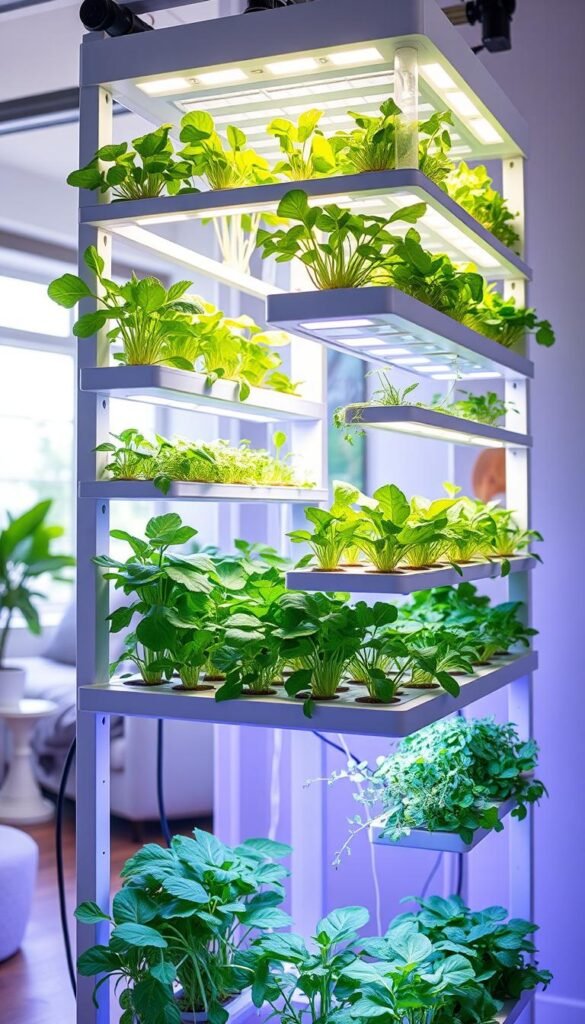
City life doesn’t mean giving up fresh greens or herbs. Across crowded metro regions, people are turning walls and windows into mini-farms. This shift started with 1930s hydroponic labs but exploded recently as tech made growing food indoors accessible. Today, 63% of urban households in the U.S. express interest in home agriculture, according to a 2023 Urban Agriculture Report.
Understanding the Urban Farming Trend
Limited space pushes creativity. In dense urban areas, every square foot counts. Stacking plants vertically lets you grow 3x more food than traditional pots. Controlled environments reduce pests and let you harvest spinach in December or tomatoes in April.
Why Choose Aeroponics for Your Living Room
While hydroponics uses water baths, aeroponics mists roots directly. This method uses 40% less water and accelerates growth by 30%. No soil means no mess—perfect for apartments. Plus, plants get more oxygen, leading to crispier lettuce and sweeter strawberries.
These systems thrive in small areas, from studio kitchens to office nooks. They’re not just for experts: automated timers handle mist cycles, so you water plants as easily as brewing coffee. It’s how modern city dwellers balance convenience with sustainability.
Understanding Vertical Hydroponics and Aeroponics
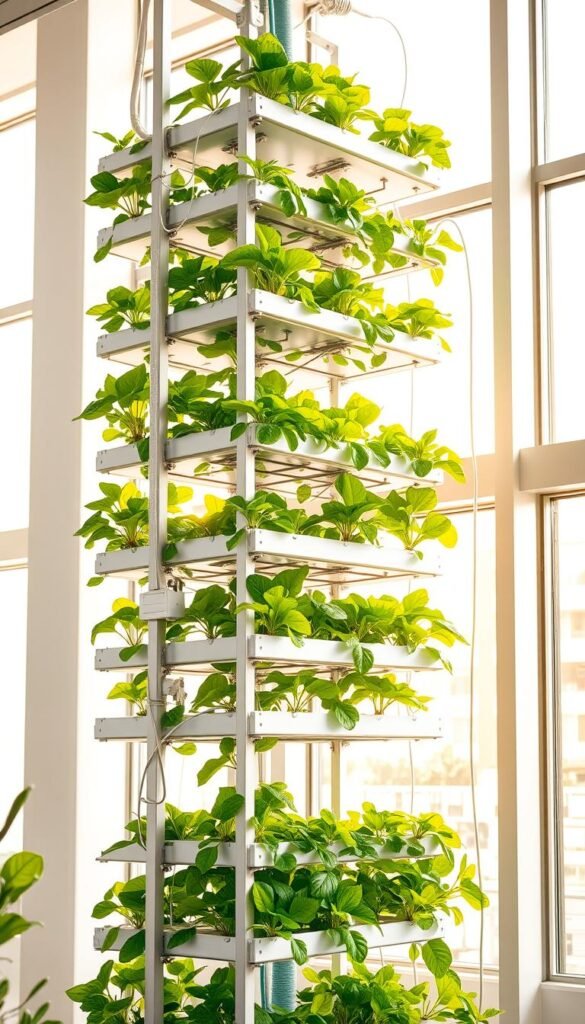
Modern agriculture meets apartment living through innovative growing techniques. Instead of relying on backyard plots, vertical setups let you nurture plants in stacked layers. Here’s how two soil-free methods stack up against conventional approaches.
How Vertical Hydroponics Works
These systems deliver nutrient-rich water directly to roots through channels or drip lines. A pump circulates the solution, ensuring plants get constant nourishment without dirt. Roots grow faster because they don’t waste energy searching for food.
Closed-loop designs recycle 90% of water, unlike traditional farming. You’ll see leafy greens mature 25% quicker than in soil. Modular setups let you expand upward as your gardening skills grow.
Comparing Growing Methods
| Method | Water Use | Space Needed | Disease Risk |
|---|---|---|---|
| Soil-Based | High | Large | Moderate |
| Hydroponics | Low | Compact | Low |
| Aeroponics | Very Low | Vertical | Minimal |
Aeroponics outperforms both by misting roots with nutrients. This system uses 60% less water than hydroponics. No soil means zero weeds and fewer pests. Plants thrive with maximum oxygen access, yielding crisp produce year-round.
Whether you choose hydroponics or aeroponics, both methods beat traditional farming in urban spaces. They turn cramped areas into productive green zones while giving you control over growth conditions.
Key Components of Your Aeroponic Tower Garden
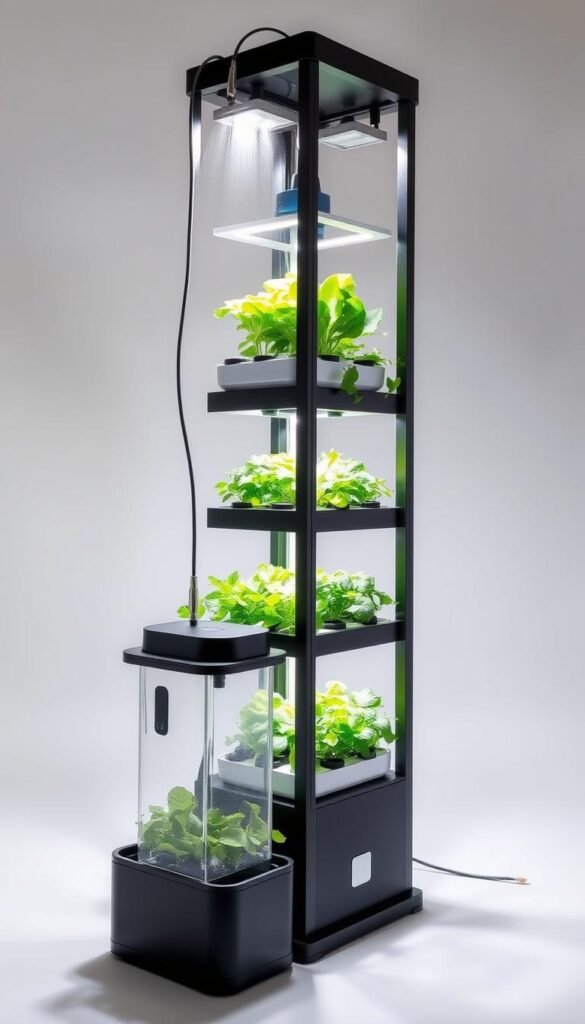
Building your own high-efficiency growing system starts with understanding its core elements. Every successful setup combines smart engineering with botanical needs—here’s what brings your garden to life.
Essential Materials and Tools
You’ll need these basics to create a thriving vertical setup:
- PVC pipes or vinyl posts (4-6″ diameter) as the main structure
- Net pots that cradle roots while allowing mist penetration
- Submersible pump with adjustable pressure (80-100 GPH ideal)
- Nutrient reservoir and timer for automated feeding cycles
Pro guides recommend silicone sealant for waterproof joints and reflective sheeting to boost light exposure. These materials ensure your plants get consistent care without daily fuss.
Designing for Optimal Growth
Spacing determines how many plants per tower thrive. Use this blueprint for common crops:
| Crop Type | Vertical Spacing | Support Needs |
|---|---|---|
| Leafy Greens | 6-8 inches | Low |
| Herbs | 4-6 inches | Medium |
| Fruiting Plants | 10-12 inches | High |
Angle your towers slightly to prevent water pooling. Connect drip lines at the top for gravity-assisted distribution—this method helps nutrients reach every root evenly. Test different configurations to see what makes your greens grow fastest.
Setting Up Your Indoor Vertical Farm
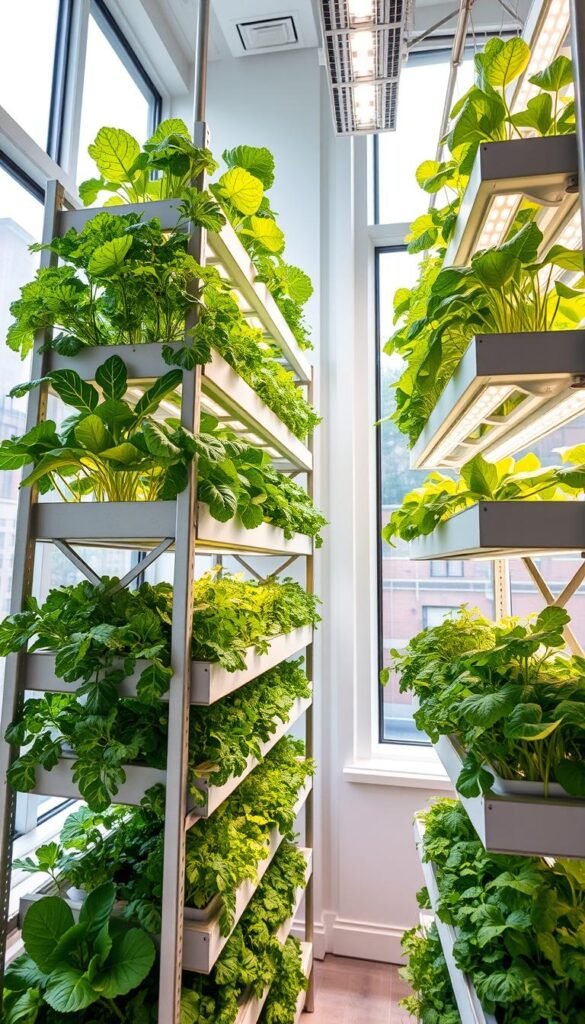
Your journey to fresh produce begins with optimizing your available area. Whether you’re using a sunny windowsill or a blank wall, smart preparation ensures your growing plants thrive. Let’s explore how to create the perfect environment for leafy greens and herbs.
Planning Space and Lighting Requirements
Measure your chosen spot carefully. Most systems need at least 2×2 feet of floor space and 5-6 feet of height. South-facing windows provide natural light for 6-8 hours daily—ideal for basil and mint. Supplement darker areas with LED panels (14-16 hours daily) for consistent growth.
| Light Source | Best For | Daily Hours |
|---|---|---|
| Natural Light | Herbs & Leafy Greens | 6-8 |
| LED Grow Lights | Fruiting Plants | 12-16 |
| Fluorescent | Seedlings | 14-18 |
Keep reservoirs 3-4 feet from electronics to prevent water damage. Use vertical planters with built-in drainage if ceiling height is limited.
Step-by-Step Assembly of Your Tower Garden
Start by connecting the base reservoir to the pump. Slide net pots into pre-cut holes, spacing them 6-8 inches apart for mature growing plants. Secure drip lines with zip ties to avoid leaks.
Fill the tank with pH-balanced water (6.0-6.5 ideal). Gently place seedlings into pots, ensuring roots touch the mist nozzles. Test the system for 24 hours before adding nutrients.
For more inspiration, explore these DIY hydroponic projects that adapt well to compact spaces. Remember—patience pays off. Your first harvest will taste sweeter knowing you built the system yourself!
Simple Aeroponic Tower Gardens: Vertical Farming in Your Living Room
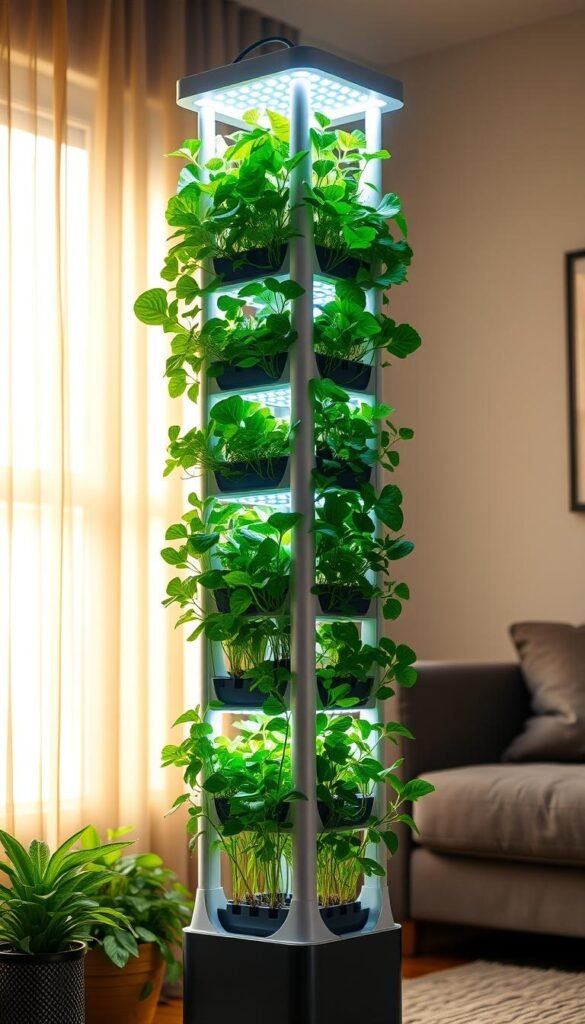
Transforming your kitchen into a fresh produce hub isn’t science fiction—it’s happening right now in apartments from Brooklyn to Austin. These innovative setups let you grow herbs, greens, and even cherry tomatoes where you’d least expect them. How? By turning unused vertical areas into productive green zones.
What makes these systems perfect for city life? They’re built for tight spaces. You don’t need a backyard when your growing area stretches upward instead of outward. The design prioritizes footprint efficiency—some units take less floor space than a standard floor lamp.
Growers cultivate crops using mist-fed roots that dangle in air pockets, eliminating bulky soil containers. This method allows growers to cultivate 3x more plants per square foot compared to traditional pots. Your basil and kale get exactly what they need, precisely when they need it.
Urban-friendly features include:
- Compact profiles fitting behind apartment doors
- Silent pumps quieter than fridge hums
- Sleek aesthetics blending with modern decor
These systems aren’t just space-savers—they’re lifestyle enhancers. Imagine snipping parsley for dinner while your tower’s LED lights cast a soft glow. This approach allows growers to cultivate fresh ingredients without sacrificing style or square footage. It’s how city residents enjoy farm-to-table living… without the farm.
Maintenance and Monitoring for Peak Performance
What does it take to keep your mist-powered garden thriving? Consistent care ensures crisp greens and plump tomatoes week after week. Think of your setup as a high-performance engine—regular tune-ups prevent hiccups and maximize yields.
Mastering Nutrient and Water Balance
Check nutrient solution levels every 2-3 days. Top off the reservoir when it drops below the ¼ mark. Use a pH tester twice weekly—aim for 5.8-6.3 to keep plants absorbing nutrients efficiently.
Refresh the solution completely every 14 days. Stagnant mixtures breed algae and weaken plant health. For best results, mix fresh batches using measured concentrates rather than topping old liquids.
Stopping Problems Before They Start
Clogged nozzles cause 80% of system failures. Flush mist lines monthly with a vinegar-water blend. Inspect roots weekly for discoloration or sliminess—early signs of disease. Isolate affected plants immediately to protect others.
Automate your cycles with timers to avoid human error. Most crops thrive with 15-minute mists every 2 hours during daylight. Pair this schedule with troubleshooting common issues guides to fix leaks or pump noises fast.
| Task | Frequency | Tool Needed |
|---|---|---|
| pH Testing | Twice weekly | Digital meter |
| Solution Change | Every 2 weeks | Nutrient mix |
| Nozzle Cleaning | Monthly | Vinegar solution |
Rotate plant positions every harvest to equalize light exposure. Wipe down tower surfaces monthly—dust blocks airflow and light penetration. With these habits, your garden becomes a low-fuss, high-reward part of daily life.
Benefits of Aeroponic Systems for Urban Gardeners
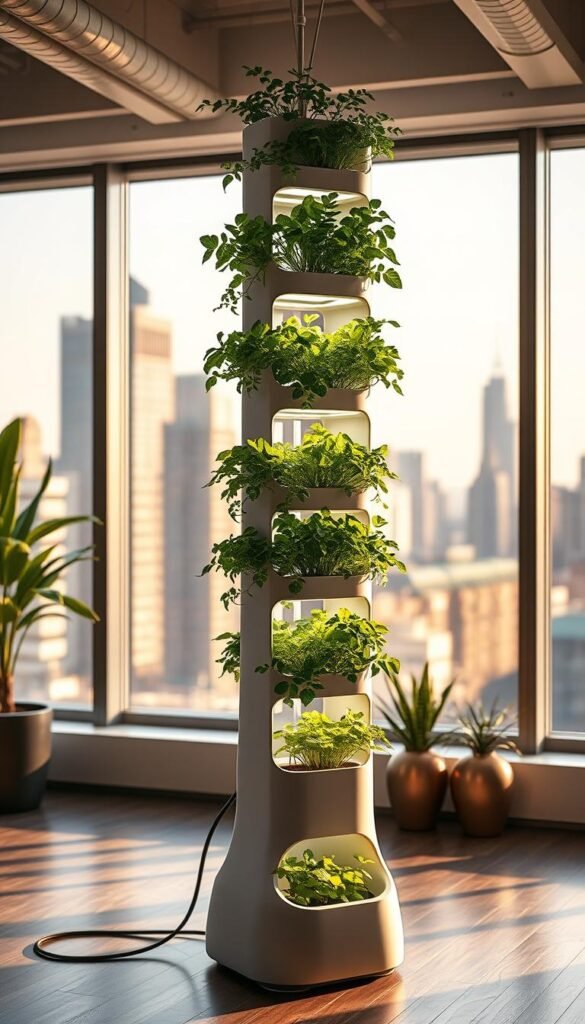
Urban spaces bloom with possibility when you harness mist-powered growing methods. These setups turn cramped apartments into productive zones while addressing modern challenges like resource scarcity and seasonal limitations. Let’s explore how this approach reshapes city living.
Efficient Use of Space and Resources
Your vertical setup grows 8-10 plants per square foot—triple what pots achieve. Roots suspended in air receive targeted nourishment, wasting zero water or nutrients. Studies show these systems use 95% less H2O than soil gardening while doubling growth rates for leafy greens.
| Resource | Traditional Gardening | Mist-Based Systems |
|---|---|---|
| Water | 100 gallons/month | 5 gallons/month |
| Floor Space | 10 sq ft | 2 sq ft |
| Herb Yield | 15 plants | 45 plants |
City residents in Chicago converted fire escapes into thriving farms using this method. One balcony now produces enough basil for three neighborhood restaurants weekly.
Year-Round Production and Sustainability
Say goodbye to seasonal shortages. Controlled environments let you harvest mint in January and arugula in July. LED-lit systems in Seattle apartments maintain 72°F root zones year-round, ensuring continuous crops despite Pacific Northwest rains.
Beyond personal benefits, these gardens reduce food miles and plastic packaging. A Brooklyn high-rise community cut their carbon footprint by 18% through collective indoor farming. Your daily salad becomes a climate action—one crisp bite at a time.
Delicate herbs like cilantro thrive in mist-rich chambers where humidity stays steady. Nutrient precision prevents overfeeding, yielding vibrant flavors unmatched by store-bought alternatives. It’s how you turn concrete jungles into edible ecosystems.
Troubleshooting and Optimizing Your Setup
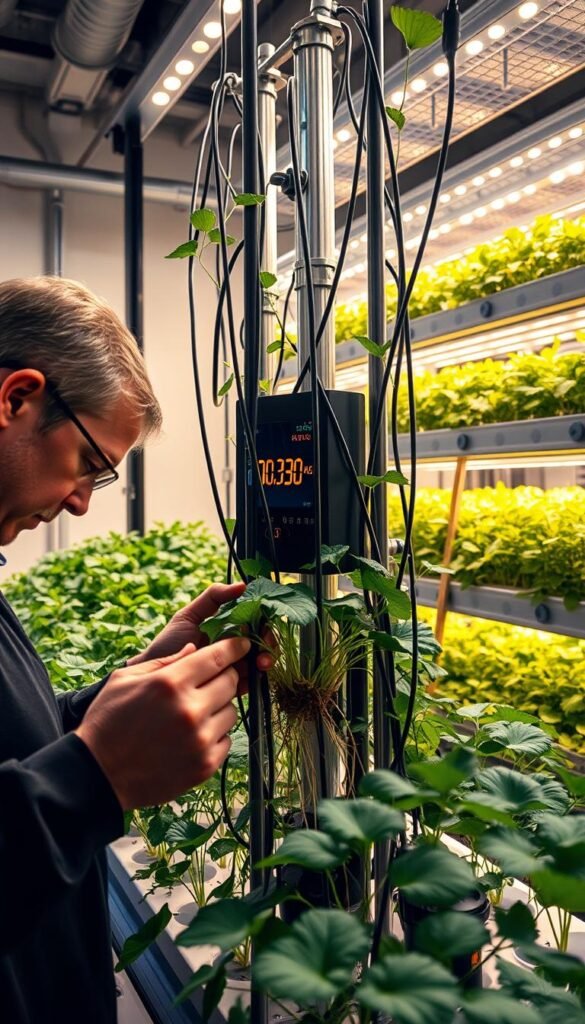
Even the best gardens hit snags—here’s how to keep yours thriving. Small adjustments often make the difference between struggling plants and bumper harvests. Let’s tackle common challenges and turn setbacks into growth opportunities.
Spotting and Fixing Growth Hurdles
Yellow leaves? Check your pH first. Nutrient lockout happens when levels drift outside 5.8-6.3. Test weekly and adjust with pH-up or down solutions. For slow-growing crops, increase misting frequency by 15%—roots need consistent moisture to absorb minerals.
Clogged nozzles starve plants of nutrients. Flush lines monthly using 1-part vinegar to 4-parts water. If pump pressure drops, inspect filters for debris. A clean system prevents 90% of mechanical issues.
| Symptom | Likely Cause | Quick Fix |
|---|---|---|
| Wilting stems | Low oxygen | Add air stone to reservoir |
| Stunted roots | Over-misting | Reduce cycle to 10 mins/hour |
| Spotty leaves | Calcium deficit | Add Cal-Mag supplement |
Rotate vegetables every harvest to balance light exposure. Basil thriving while kale struggles? Move shade-tolerant greens to lower slots. Track changes in a journal—patterns emerge faster than you’d think.
Prevent algae by painting reservoirs black or using light-blocking covers. Still seeing slime? Add 1 tsp hydrogen peroxide per gallon of water. These tweaks keep your crops healthy without harsh chemicals.
Advanced Tips for Maximizing Yield and Efficiency
Elevate your indoor garden’s performance with smart tech and creative strategies. Pairing modern tools with clever planting methods unlocks new levels of productivity—even in limited spaces. Let’s explore how to push your setup beyond basic functionality.
Incorporating LED Grow Lights and Automation
Not all lights are created equal. Full-spectrum LED panels mimic sunlight best, boosting leaf growth by 40% compared to standard bulbs. Position them 12-18 inches above plants and use timers for 14-hour daily cycles. Studies show this combo increases basil yields by 22% while cutting energy costs 30%.
Automate tedious tasks with smart sensors. Connect your pump to a moisture detector—it’ll trigger misting only when roots dry out. Denver apartment growers report 50% less water waste using this method. Pair it with a nutrient doser for hands-free feeding.
Experimenting with Different Crops and Techniques
Diversify your harvests by testing types beyond leafy greens. Compact strawberries and dwarf tomatoes thrive in mist environments. Try companion planting—pair mint with lettuce to naturally repel aphids. Rotate crops every 8 weeks to maintain soil-free nutrient balance.
Track results with this simple chart:
| Crop | Light Type | Yield Increase |
|---|---|---|
| Kale | Full-Spectrum LED | 35% |
| Basil | Red/Blue Combo | 28% |
| Chili Peppers | Warm White LED | 19% |
Boost success rates by starting with these apartment gardening tips. Remember—every tweak teaches you more about your plants’ needs. Soon you’ll harvest like a pro, even in cozy urban spaces!
Final Thoughts on Growing Your Own Indoor Vertical Farm
Turning your home into a fresh food oasis is easier than you think. Soil-free systems let you grow herbs and greens with minimal space—no backyard required. By stacking plants upward, you’ll use 90% less water than traditional methods while harvesting crisp produce every week.
Key benefits stay clear: year-round crops, pest-free environments, and full control over your food’s journey. Whether starting with basil or scaling to tomatoes, these setups adapt to your skills. Automated timers and smart lighting make maintenance simple, even for first-timers.
Remember—success begins with small steps. Test one tower before expanding. Monitor pH levels closely, and rotate crops for balanced growth. Your efforts pay off in salads packed with flavor and reduced grocery bills.
Indoor cultivation isn’t just trendy—it’s a sustainable leap forward. Each harvest supports eco-friendly living while transforming unused corners into thriving green zones. Ready to redefine how you grow? Your future harvests await.
